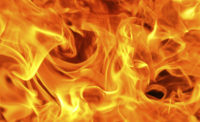As a safety auditor or inspector, it is our responsibility to find hazards, potential hazards, or dangerous situations to prevent injury, loss of work, and most severely the death of an employee or patron. The primary functions of a safety professional include risk management, accident prevention, and ensuring compliance with workplace safety rules and regulations. Safety auditors are proficient in finding OSHA violations or deficiencies; however, fire protection issues are often overlooked because the safety auditor is unaware or not familiar with their nuances.
More thorough inspections
Consider automatic fire sprinkler systems, they are the single most effective means of fighting the spread of fires in their first stages. Fuel, oxygen, and heat are needed for a fire to start; all three elements are present in every building that we work or live in. Fuels such as wood, couches, Curtains, paper, and plastics are combustible and or flammable. These materials are present in our places of business and where we live. Heat is generated by electrical appliances and fixtures. And the fact that we humans are walking around and alive shows that oxygen is present.
A safety inspector notes that a flammable liquid storage cabinet is needed, to safely store flammable and or combustible liquids. But the safety inspector does not note that there are corroded, painted, or rusted sprinkler heads in the facility. The 2023 Edition of NFPA 25: Standard for the Inspection, Testing and Maintenance of Water-Based Fire Protection Systems states in Section 5.2.1.1.1 that any sprinkler that shows signs of any of the following shall be replaced:
(1) Leakage
(2) Corrosion detrimental to sprinkler performance
(3) Physical damage
(4) Loss of fluid in the glass bulb heat-responsive element
(5) Loading detrimental to sprinkler performance
(6) Paint, other than that applied by the sprinkler manufacturer, detrimental to sprinkler performance.
The reason corroded, painted, or rusted sprinkler heads are safety issues or deficiencies is because these situations can block, impair, or cause fire sprinkler heads to malfunction or not function properly in a fire emergency. A non-manufacturer painted sprinkler head may not activate in a fire. Contrary to what is shown in movies fire sprinkler heads do not activate all at once when a fire alarm pull station is tripped. Sprinkler heads activate directly over the fire area other fire sprinkler heads do not activate in areas where there is no fire present.
A corroded or rusted fire sprinkler head may activate but the flow of water from the piping could be compromised because of blockages in the piping caused by accumulation of corrosion or rust inside the piping. Sprinkler heads are designed to produce predetermined flow rates when activated. Flow rate is a function of pipe and orifice diameter. For example, a one-inch pipe that is 50% blocked by rust or corrosion generates 55% to 60% less water flow over a fire. Let’s say that the designed water flow for the sprinkler head is 100 gpm (gallons per minute) with a 50% blockage the water flow is reduced to 40-gpm. To give a little perspective, a flow of water that is 100-gpm can put out a car fire; 40-gpm is a garden hose.
Fire extinguishers violations
Another group of fire protection deficiencies that are commonly missed is portable fire extinguishers. Portable fire extinguishers that are not mounted or are overdue for annual inspection and service are among the most common fire code violations cited by fire inspectors. Fire extinguishers are needed in every type of building per the National Fire Code. Portable fire extinguishers are to be used to prevent a small fire from becoming a big fire. NFPA 10 Section 5.1.2 states “the selection of extinguishers shall be independent of whether the building is equipped with automatic sprinklers, standpipe and hose, or other fixed protection equipment.”
In other words, even if the building has a fire sprinkler system a fire extinguisher is still needed. The USFA (United States Fire Administration), and your local fire department subscribe to the philosophy that if the fire sprinkler system activates, they are at a disadvantage, behind the eight ball, so to speak. Proper use of a portable fire extinguisher can stabilize a fire incident, in that it puts out small fires before the sprinkler system can activate.
The vast majority of safety professionals know what the acronym P.A.S.S. stands for, on portable fire extinguishers, Pull Aim Squeeze Sweep. NFPA 10: Standard for Portable Fire Extinguishers, requires that portable fire extinguishers be serviced and inspected on an annual basis. NFPA 10 Section 7.2.2 outlines some of the things that must be done to manually inspect fire extinguishers, (1) Location in designated place (2) Visibility of the extinguisher or means of indicating the extinguisher location (3) Access to the extinguisher (4) Pressure gauge reading or indicator in the operable range or position (5) Fullness determined by weighing or hefting.
The last item mentioned shows that a fire extinguisher must be picked up as part of the annual inspection. As a fire and building inspector, I have met situations where the fire extinguisher contractor just looked at the gauge and changed the tag. The contractor did not do the things needed to adequately conduct an annual inspection of portable fire extinguishers.
Section 7.3.2.1.1 of NFPA 10 States: At the time of the annual external visual examination, a check of at least the inspection items of 7.2.2 and the external examination items of 7.3.2.1 shall be conducted. 7.3.2.2 Seals or Tamper Indicators. At the time of the maintenance, the tamper seal of a rechargeable fire extinguisher shall be removed by operating the pull pin or locking device.7.3.2.2.1 After the applicable maintenance procedures are completed, a new listed tamper seal shall be installed. So just changing the fire extinguisher inspection tag is not enough to constitute a compliant annual inspection.
Increase awareness
There are other fire protection issues that are overlooked or are not considered doing a safety audit or inspection that will not be mentioned in this article. However, I encourage safety professionals to learn more about fire safety and fire protection systems. It is essential that safety professionals increase their knowledge and understanding of fire protection. Sources for information include NFPA Codes, ICC (International Code Council), Local, Fire, and Building Officials.
My intention for authoring this article is to increase awareness of fire protection deficiencies that can negatively affect the overall safety of a building and facility. If a fire emergency occurs and someone is hurt or killed. Among the first things investigating officials will look for are fire inspection reports. Uncorrected fire protection issues expose business/ building owners to litigation. Functioning fire protection systems and equipment help ensure the overall safety of building occupants and patrons. It is essential that safety professionals be aware of fire protection systems and equipment.




